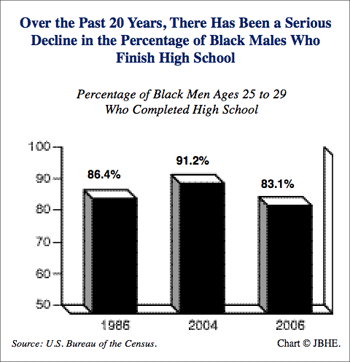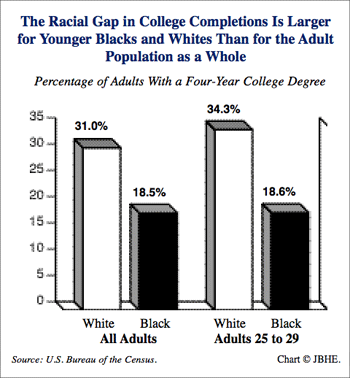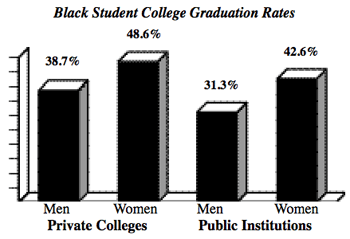Huge Black-White Disparities Persist in Educational Attainments
Overall data on educational attainment in the United States includes a large group of older blacks who reached adulthood at a time when African Americans were almost totally excluded from higher education. The inclusion of these older blacks in the statistics has always been viewed as distorting the current picture of the educational progress of African Americans.
Unfortunately, when we limit the count to blacks who were born after the civil rights era, very large racial gaps in educational attainment continue to persist.
Today in the United States, 18.5 percent of all African-American adults over the age of 25 hold a four-year college degree. For white adults over the age of 25, the figure is 31 percent. The gap is huge!
This data from the Census Bureau and the Department of Education on educational attainment of African Americans always has been viewed as seriously misleading. The reason is that the statistics on the educational attainment of African-American adults include millions of blacks who grew up prior to the civil rights era when Jim Crow prevailed and when throughout the nation there were severely restricted higher educational opportunities for African Americans.
 Now, new data from the Census Bureau for 2006 permits us to examine the educational attainment of blacks and whites in the 25- to 29-year-old age group. This provides comparative data on blacks and whites who were born in the years 1976 to 1980. These Af-rican Americans came into the world well after the Brown v. Board of Education decision ending racial segregation in public schools. Also, these blacks ages 25 to 29 were born after the civil rights era. In addition, they reached college age at a time when higher education was generally open to blacks and when affirmative action and race-sensitive admissions were still widely practiced in the United States. Now, new data from the Census Bureau for 2006 permits us to examine the educational attainment of blacks and whites in the 25- to 29-year-old age group. This provides comparative data on blacks and whites who were born in the years 1976 to 1980. These Af-rican Americans came into the world well after the Brown v. Board of Education decision ending racial segregation in public schools. Also, these blacks ages 25 to 29 were born after the civil rights era. In addition, they reached college age at a time when higher education was generally open to blacks and when affirmative action and race-sensitive admissions were still widely practiced in the United States.
By comparing this group of young blacks with whites of similar age groups, we almost certainly get a better indication of the current gaps in educational opportunity between African Americans and whites without the added baggage of data on African Americans from an earlier time when racial discrimination was rampant and higher education for blacks was rare.
Regrettably, this adjustment of high school and college completion figures excluding older blacks does not produce improved results. In fact, the racial gap in college completions for young blacks ages 25 to 29 is actually wider than the gap for black and white adults as a whole, including those adults who were raised during the Jim Crow era. This is due to recent declines in high school and college completions among young blacks in this narrow, five-year age span.
Here are the detailed statistics: In 2006, 85.6 percent of young blacks ages 25 to 29 had completed high school. This was the lowest percentage since 1996. For whites ages 25 to 29, 93.4 percent had completed high school. The drop in high school completions for young blacks in all likelihood is due to the low rate of high school graduations of black males. In 2006, 83.1 percent of black men ages 25 to 29 had a high school diploma. Just two years earlier in 2004, more than 91 percent of black males in that age group had completed high school. Twenty years ago in 1986, 86.4 percent of black males in the 25 to 29 age group had graduated from high school.
The white percentage of high school completers has fluctuated very little over the past decade. Therefore, the gap in high school completions between young blacks and whites has increased in the first years of this century.
 The College Completion Gap The College Completion Gap
For blacks in the 25- to 29-year-old age group, 18.6 percent hold a four-year college degree. This is only slightly better than the rate for black adults as a whole. For whites in this age group, 34.3 percent hold a four-year college degree. This is 3.3 percentage points higher than the white adult population as a whole. Therefore, the college completion rate gap between young blacks and young whites is actually larger than for the population as a whole.
These figures are discouraging and portend a solid and continuing economic gap between the races for the foreseeable future. If, as appears to be the case, the educational gap between young blacks and whites is larger than the educational gap for black and white adults as a whole, it is almost certain that racial gaps in income, wealth, poverty, and unemployment will persist for generations to come.
New Education Department Data Shows a Persisting Racial Gap in College Graduation Rates
New figures from the U.S. Department of Education find that nationwide only 40.4 percent of all black students who entered all four-year colleges and universities in the United States in 1999 graduated within six years. For whites, the overall graduation rate was 58.9 percent.
The graduation rate gap was larger for students at private colleges and universities than it was at state-operated institutions. The graduation rate for black students at private colleges and universities was 44.5 percent. For white students at these institutions, the graduation rate was 66.2 percent.
At public institutions, the black graduation rate was 38.1 percent. For whites at state-operated colleges and universities, the graduation rate was 55.2 percent.
The data also shows a large gender gap in black student graduation rates. At private colleges and universities, black women have a graduation rate of 48.6 percent. For black men at private colleges and universities, the graduation rate was nearly 10 percentage points lower at 38.7 percent. At all public four-year institutions the gender gap was even greater among African Americans. Black women posted a graduation rate of 42.6 percent at state-operated institutions. For black men, the graduation rate was considerably lower at 31.3 percent.
 The Education Department figures also looked at completion rates for students who entered community college in 2002. Only 27.2 percent of black students who entered two-year community colleges in 2002 earned an associate’s degree by 2005. For whites, the success rate of students entering community college in 2002 was only slightly higher at 33.8 percent. The Education Department figures also looked at completion rates for students who entered community college in 2002. Only 27.2 percent of black students who entered two-year community colleges in 2002 earned an associate’s degree by 2005. For whites, the success rate of students entering community college in 2002 was only slightly higher at 33.8 percent.
There was very little difference between black men and black women at state-operated community colleges. But at privately operated two-year colleges, black women have a graduation rate of 44.3 percent compared to 34.7 percent for black men. |
